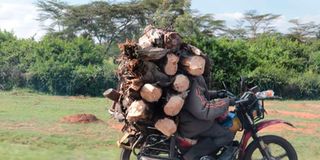Scientists warn against overuse of wild species

A boda Boda rider ferrying firewood along the busy Nakuru-Eldoret Highway.
What you need to know:
- Developing countries like Kenya have been touted by the authors of the report to be ‘at most risk’, saying that 70 per cent of the world’s poorest people depend on the wild species.
- With about 50,000 wild species used through different practices, including more than 10,000 wild species harvested directly for human food, rural people in developing countries are most at risk from unsustainable use, with lack of complementary alternatives often forcing them to further exploit wild species already at risk.
A new global study warns people against over-exploiting wild species such as plants, animals, fungi and algae as it threatens their extinction.
Billions of people worldwide rely on 50,000 wild species for food, energy, medicine and income, according to the report, which concluded that humans must make dramatic changes to fishing, hunting , logging and other practices to address an accelerating biodiversity crisis. The four-year assessment done by 82 scientists drawn from different parts of the world whose work has been published by the Intergovernmental Platform on Biodiversity & Ecosystem Services shows that short-term profit from wild species has a direct link to nature loss.
The researchers found out that illegal trade in wild species makes it the third largest class of all illegal trade amounting to an annual value of Sh23 trillion (USD 199 billion) –logging, and fishing are the likely culprits for the illegality.
“The survival of an estimated 12 per cent of wild tree species is threatened by unsustainable logging; unsustainable gathering is one of the main threats for several plant groups, notably cacti, cycads and orchids, and unsustainable hunting has been identified as a threat for 1,341 wild mammal species – with declines in large-bodied species that have low natural rates of increase also linked to hunting pressure,” said the report.
Developing countries like Kenya have been touted by the authors of the report to be ‘at most risk’, saying that 70 per cent of the world’s poorest people depend on the wild species.
“With about 50,000 wild species used through different practices, including more than 10,000 wild species harvested directly for human food, rural people in developing countries are most at risk from unsustainable use, with lack of complementary alternatives often forcing them to further exploit wild species already at risk,” said Dr Jean-Marc Fromentin, co-chair of the Assessment.
Dr Marla Emery, another co-author from the United States, acknowledges that while wild species are important in our day-to-day lives as they are sources of food, medicine, cosmetics, among others, their proliferation has grown exponentially.“One in five people rely on wild plants, algae and fungi for their food and income; 2.4 billion rely on fuel wood for cooking and about 90 per cent of the 120 million people working in capture fisheries are supported by small-scale fishing,” she said in a statement.
The report also looked at the likely future scenarios for the use of wild species, finding that climate change, increasing demand and technological advances -making many extractive practices more efficient – will be key drivers to challenges of sustainable use in the future.
The authors suggest that in fishing, governments should reduce illegal, unreported and unregulated fishing, suppress harmful financial subsidies, support small-scale fisheries, adapt to changes in oceanic productivity due to climate change; and proactively create effective transboundary institutions.
On logging, they advise that governments should enforce management and certification of forests for multiple uses; technological innovations and reduce waste in manufacturing of wood products. They should also come up with economic and political initiatives that recognise the rights of indigenous peoples and local communities, including land tenure.




